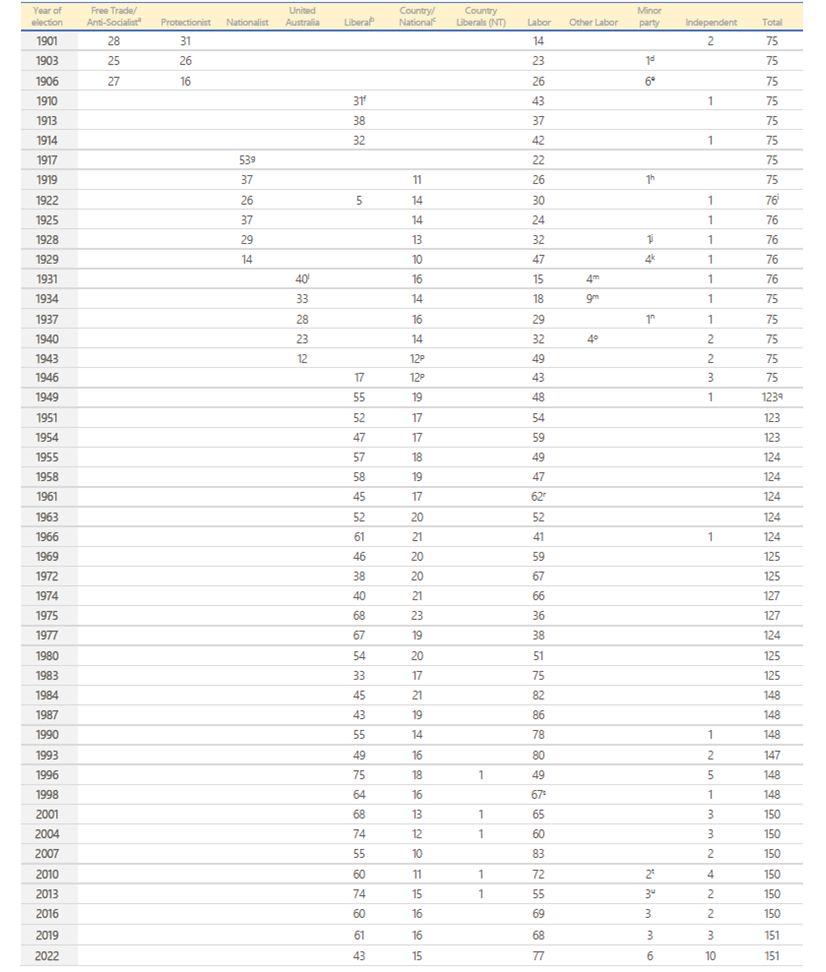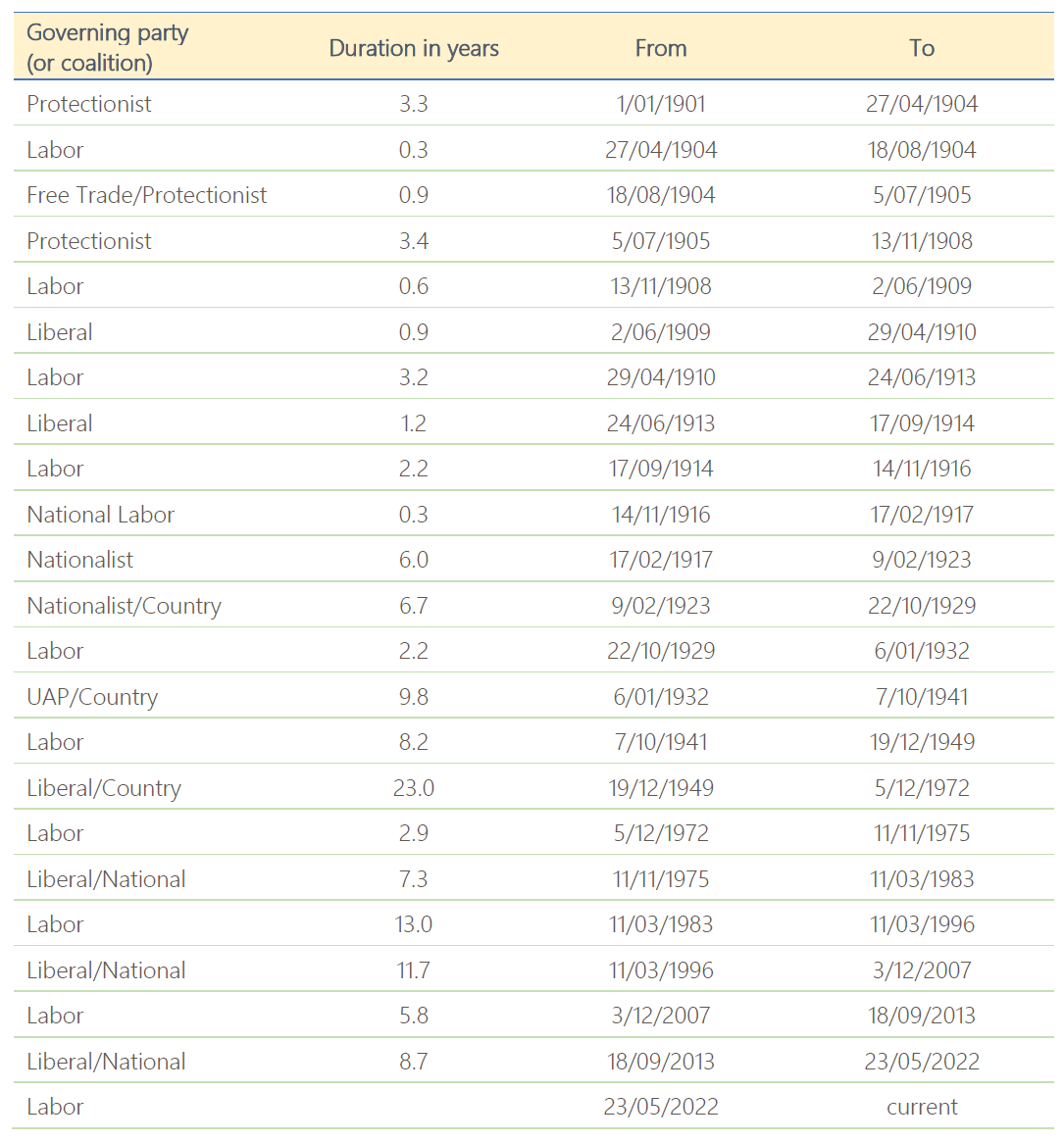Australia’s system of government is based on the existence of political parties. While the Members of the House of Representatives are individually elected to represent constituents within each electoral division, in most cases Members belong to and support a political party.
Parties and the formation of government
The party (or coalition of parties) which has the support of the majority of Members of the House forms the government. The party (or coalition of parties) with the greatest number of non-government Members in the House forms the official opposition. Each parliamentary party (that is, all Members and Senators of the party) elects its own leader—the leaders of the government and opposition parties become the Prime Minister and Leader of the Opposition, respectively.
A hung Parliament is said to exist when no single party or coalition of parties has a majority of seats in the House of Representatives. A minority government can be formed when a party or coalition, which does not have a majority of seats in its own right, is able to achieve a majority on the floor of the House with support from independent Members or minor parties.
Between 1901 and 1910, allegiances to party were more fluid than they would later become; governments were minority governments and were made and unmade on the floor of the House. Since 1910, Australia has generally had majority governments under which either the Australian Labor Party or a coalition of non-Labor parties has held office.
The main political parties in the House of Representatives
There are three main parties represented in the House of Representatives—the Australian Labor Party, the Liberal Party of Australia, and the Nationals. The Labor Party is Australia’s oldest political party, established federally in 1901.[1] The present Liberal Party was formed in 1944. The Country Party was formed in 1920, renamed the National Country Party in 1975, the National Party of Australia in 1982, and since 2003 has been known as the Nationals.
In 2008 the Queensland branches of the Liberal Party and the Nationals merged to form the Liberal National Party of Queensland. However, Liberal National Party candidates elected to the Federal Parliament have continued to sit as Liberals or Nationals.
Since the general election of 1949, the Liberal Party and the Nationals (under various names) when forming government have done so as a coalition.
Minor parties and independents
Since the general election in 1949 the other parties represented in the House have been:
- Australian Labour Party (Anti-Communist)[2] – 1955 (seven former members of the Australian Labor Party);
- One Nation – 1997 (one former independent Member)
- Australian Greens – 2002 (one Member), 2010 (one Member), and from 2022 (four Members)
- Nationals (Western Australia) – 2010 (one Member)
- Katter’s Australia Party – from 2013 (one former independent Member)
- Palmer United Party – 2013 (one Member)
- Centre Alliance, formerly Nick Xenophon Team – from 2016 (one Member)
- United Australia Party – 2021 (one former Liberal Party Member).
Most Parliaments since 1996 have also had a Member from the Northern Territory based Country Liberal Party; however this party has been part of the Liberal–Nationals coalition.
In recent Parliaments there have been up to sixteen independent Members elected or Members of minor parties elected.
Significant parties historically
Other parties which have formed government:
- Protectionist Party, 1889–1909. Formed first federal government with Labor Party support;
- Free Trade Party, 1889–1909. Renamed Anti-Socialist Party in 1906
- Commonwealth Liberal Party, 1909–16. Formed from Anti-Socialist Party and elements of the Protectionist Party (also called ‘the Fusion’)
- National Labor Party, November 1916–February 1917. Formed from elements of the Labor Party
- Nationalist Party, 1917–31. Formed from merger of the National Labor Party and Commonwealth Liberal Party
- United Australia Party, 1931–45. Formed from Nationalist Party, Australian Party (former Nationalists) and elements of the Labor Party. Predecessor to the modern Liberal Party.
Parties and the operation of the House of Representatives
Parliamentary activity involves the parliamentary wings of the political parties—that is, the elected representatives. The extra-parliamentary or organisational wings of the political parties have no role in the formal parliamentary structure and workings of the Parliament.
Political parties are not formally recognised in the standing orders of the House. However, in many respects the functioning of the House is based on the relationship between government and opposition—that is, the opposing political parties. The working arrangements and conduct of business reflect this division. This can be seen in the physical layout of the Chamber, with government Members sitting to the right of the Speaker’s Chair and opposition Members to the left. Another example is the practice that opportunities for Members to speak in the House are alternated between government and non-government Members.
Party meetings
The major parties have designated party rooms in Parliament House. Parties have meetings in sitting weeks, usually at times when the House is not sitting, where all members of the party in the Parliament (that is, Senators and Members) meet together. These meetings are a forum for communication between backbenchers and party leaders, internal party discussion of party policy, parliamentary activity and tactics, the resolution of internal party disputes and the election of officers. The proceedings of party meetings are regarded as confidential, and details of discussions are not normally made public.
Party committees
Both the government and the opposition parties have backbench committees to assist them in the consideration of legislative proposals and other issues of political significance. These committees provide backbenchers with the opportunity to discuss matters and influence party policy or decisions in particular subject areas.
Party whips
All parties have whips whose main function is to act as administrative officers to their parliamentary parties. Although whips, and especially the Chief Government Whip, have duties in relation to the proceedings of the House, they occupy essentially party positions. Outside the Chamber, the whips may be required to provide support for such matters as party meetings and consultations, party committees, arranging party nominations to parliamentary committees and organising any party balloting which may be required.
Parties in the Senate
The system of proportional representation used to elect Senators results in more opportunity for the election of minority parties and independents. This has meant that minor parties with a significant and often influential Senate presence may have no or little representation in the House (for example, previously the Democratic Labor Party and the Australian Democrats, and more recently the Australian Greens).
Further information on political parties in the House of Representatives is displayed in tables 1 and 2 below.
[1] Established in colonial Parliaments from 1891. ‘Labour’ until 1912.
[2] This later became the Democratic Labor Party, 1957–78 (not represented in the House).
KEY TO TABLE 1
Party strengths indicated are those after general elections and do not allow for by-elections, changes in affiliation between elections or as a result of elections declared void and recontested.
- The Free Trade Party was renamed the Anti-Socialist Party in 1906.
- Members of the Liberal and Country League (South Australia) included from 1946.
- The Country Party was formed after the 1919 election from Members returned under endorsement of primary producers’ organisations. In 1975 party name changed to National Country Party of Australia. In 1982 party name changed to National Party of Australia and in 2003 to the Nationals.
- Revenue Tariff Party.
- Includes 4 Independent Protectionists and 2 Western Australia Party.
- Derived from elements of former Protectionists and Anti-Socialists. Also referred to during election as ‘Fusion’.
- Formed by elements of Labor Party and former Liberals.
- Independent Nationalist.
- From 1922 total figure includes a Member for the Northern Territory who did not have full voting rights until 1968.
- Country Progressive.
- Includes 3 Independent Nationalists and one Country Progressive.
- Formed by elements of the Labor Party and former Nationalists.
- NSW Labor.
- Independent United Australia Party.
- Non-communist Labor.
- Includes one Liberal Country.
- From 1949 includes a Member for the ACT who did not have full voting rights until 1966.
- Although the Labor Party had the same number of seats as the coalition parties (62), two of its Members (Northern Territory and the ACT) did not have full voting rights.
- Includes one seat filled at a supplementary election held after the first meeting of the new House.
- Includes one Australian Greens and one Nationals (Western Australia).
- Includes one Australian Greens, one Katter’s Australia Party and one Palmer United Party.
This table is based on the table at Appendix 10 of House of Representatives Practice. Note that early records and subsequent histories do not always agree on party affiliations.
TABLE 1: Party affiliations in the House of Representatives

TABLE 2: GOVERNMENT PARTIES—periods in office
